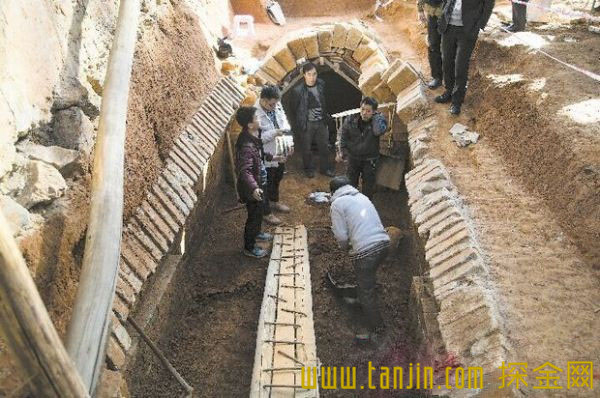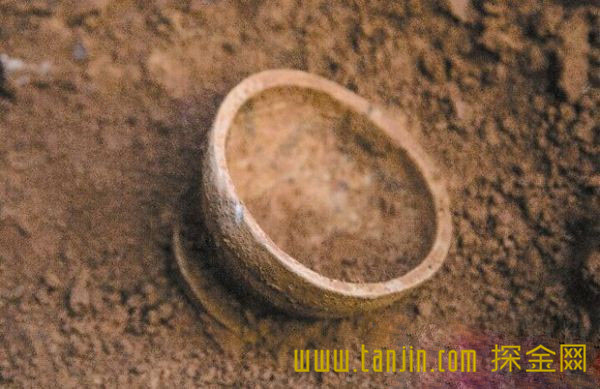The eastern Han Dynasty tomb in Shifeng District of Zhuzhou has been excavated for more than 10 days tombs or as "local tyrants and q...

Workers excavate tombs on site

Ceramic lamp excavated from a tomb
On November 25th, the construction team was inadvertently digging on a road that was being rebuilt in Tianxin, Shifeng District. An Eastern Han Dynasty tomb was seen again.
After more than 10 days of excavation, 7 pieces of cultural relics such as pots, iron kettles, and pottery lamps in the tomb have appeared. When was the tomb built in the Eastern Han Dynasty? What was the owner of the tomb? Yesterday, the reporter went to the excavation site and asked the staff of the Cultural Relics Bureau.
At 3 o'clock in the afternoon yesterday, reporters rushed to the excavation site to see that the entire tomb was more than 9 meters long and 2 meters wide. The tomb wall is made of blue bricks. The thickness of the green brick is about 6 cm. The whole tomb is arched and made of wedge-shaped bricks. The entire tomb faces the south and the south side of the tomb is a one-meter-long ramp. In addition to the clay pots unearthed three days ago, the staff also excavated artifacts such as iron kettles and pottery lamps in the tombs.
The reporter saw that the newly unearthed iron cauldron had been rusted and was more than 10 centimeters in diameter. Chen Xiaohua, deputy director of the Municipal Bureau of Cultural Relics, speculated that the iron kettle may be used by people at the time to cook. Newly unearthed is an earthenware lamp, with a lamp socket 7-8 cm in diameter and the base is buried underground.
These newly unearthed cultural relics were covered by specialized staff bags and put in place.
According to Chen Xiaohua, according to his many years of excavation experience, the funerary objects of the Eastern Han Dynasty tomb are generally used for cooking utensils, such as kettle tripod; pots and other containers for storing food, water and other items; and for eating Food utensils, such as dishes, etc., these items are closely related to life.
Although the outline of the entire tomb is clearly visible, what confused Chen Xiaohua is that the tomb currently being excavated is composed of tombs and ramps, and there are no tombs.
According to Chen Xiaohua, according to China's tradition, there is generally an open cut tomb outside the ramparts of the tomb, and the tomb is either a gentle slope or a ladder. However, during the excavation process, the staff did not find the tomb's tomb. "I have been encountering archaeology for several decades and I have encountered it for the first time. We must continue to dig in order to solve this puzzle," said Chen Xiaohua.
[Related News] The owner of the tomb may be the "local tyrant" in the early Eastern Han Dynasty
Yesterday, during the excavation process, Chen Xiaohua did not speculate on the size of the bricks in the tombs and the size of the tombs. The owner of the tomb may be the owner of a manor in the early Eastern Han Dynasty.
The cemetery has not been placed in the bricks of the epoch, which may not be popular in the early years of the Eastern Han Dynasty.
Zhuzhou has previously excavated a number of Eastern Han tombs . They all have one feature: There is a brick of the year in the decorative bricks in the tomb to illustrate the specific year in which the tomb was built. For example, the Evening News reported on June 16 this year that there was a Han Dynasty tomb in the town of Jingling, Ji County. However, the excavation of this tomb of Tian Xin has been completed half, and the staff has not yet found a brick.
In response, Chen Xiaohua explained that before they discovered a large-scale Han tomb in Yi County, the tomb had no history. "Tian Xin's Tomb of the Eastern Han Dynasty and the Han Tomb of Lixian County had one thing in common, and the decoration of the decorative bricks was relatively simple." The reporter saw in the Tian Handong Han tomb that the decoration on the tomb decorating bricks is concentric and semi-circular. In the middle is a vertical bar, a cross bar, or three bars. "This is one of the features of the Eastern Han Dynasty."
According to Chen Xiaohua's analysis, the reason why this Eastern Han Dynasty's tomb was not dated was probably due to the fact that it was not popular at that time. In the Tombs of the Eastern Han Dynasty discovered in Zhuzhou, there were many decorative bricks with different patterns. Based on the above two points, Chen Xiaohua guessed that "this burial chamber is likely to be built in the early Eastern Han Dynasty."
The burial chamber is large and the owner may be a manor
What is the identity of the owner of the tomb? Chen Xiaohua said that at present it can only be judged by the size of the tomb. "The size of this tomb is large in Zhuzhou, and its owner should have a certain status and influence in the local area."
According to Chen Xiaohua, today's Zhuzhou City has no cities in the Eastern Han Dynasty. Zhuzhou built the city, Sun Quan is located in the vicinity of Qingyunshan Jianning City, as a military fortress to defend Liu Bei, from Changsha, Fuling, Lixian County and other larger cities are far. Coupled with the sparsely populated southern region at the time, it is not easy to build such a tomb.
Chen Xiaohua said that the Eastern Han Dynasty was a period of strong and powerful growth. At that time, the country's manor was all over and a manor was equivalent to an independent small kingdom. The owner of the manor not only had family slaves, but even had private armed forces in the late Eastern Han Dynasty. The owner of this tomb was probably a manor owner, who may have thousands of acres of land. Especially in the early years of the Eastern Han Dynasty, after the rule of Ming Dynasty, the rapid economic development of the Eastern Han Dynasty also created economic conditions for the tomb owner to build such a tomb. “According to the current words, the tomb owner is today's local tyrant.â€
ã€Related Reading】
The oldest tomb found in Zhuzhou
Age: Paleolithic, 200,000 years ago
Place: Neting Town, Ji County
On September 26, 2013, the Municipal Bureau of Cultural Relics and the County Cultural Relics Bureau conducted a survey of the Dongzhou-Hanjin Jin period tombs of the Jingling Township in Qixian County. During this period, the Paleolithic excavated sites on the ship-shaped slope were discovered and they were found in the Quaternary strata of the reticulated red soil. Discover 3 stone tools. After identification, these 3 stone tools are about 200,000 years ago. Three pieces of stone tools belong to the device, the shape of the device is pointed, stone and stone core.
The experts of the Municipal Bureau of Cultural Relics believe that the discovery of the Paleolithic excavation site of the ship-shaped slope enriches the remains of the Paleolithic era in the Zhuzhou area. It is worth mentioning that the tip was unearthed in our city for the first time. It is a major discovery of prehistoric archaeology in our city and is expected to push the human history of Ji County 200,000 years ago. It also fills the gap of Zhuzhou's Paleolithic culture.
The largest tomb group has been discovered in Zhuzhou
Times: Eastern Han Dynasty, around 1900
Place: Neting Town, Ji County
The network of Yangjiazhou Han Tombs is 5 km long from north to south and 4 km from east to west. The distribution range is about 21 km2. There are thousands of ancient tombs from the Eastern Zhou Dynasty to the Han and Jin Dynasties. There are both indigenous tombs. There are also the tombs of the Chu people who came with the military occupation. The wide range of distribution, the large number of tombs, and the huge shape system are rare in the Hunan area and are comparable to the Mawangdui Mausoleum in Changsha.
The tombs successively carried out four archaeological excavations from 1985 to 2010. A large number of cultural relics unearthed in 100 tombs ranged from copper tripods to Wuyiqin to gongs, chisels and other labor tools, all-inclusive, highly protective and historically studied. value. The existence of Yang Jiazhou's Han Dynasty tomb provides important material information for the study of the conditions of the closure of the king's residence in Changsha and the situation of setting up the county in the eastern part of the Han Dynasty. According to archaeological experts, this ancient tomb may be the tomb of a prince of ancient Changsha.
1.Nt Tool Holders for mechanical spindle and cutting tool and other accessory tool connection. Is a simple, popular spindle shank connection standard, mainly 2.NT30 NT40 NT50... Etc.. Mold industry, and high-speed engraving machine, used more.
3.At present the main traditional CNC Machine tool accessories standard NT Tool Holder(DIN2080)
4.we can to figure to sample processing, and perfect after-sales service and technical support. Looking forward to your cooperation!
Nt Tool Holders,Nt Er Powerful Collet Chuck,Nt40-Oz Collet Chucks,Nt Er Collet Chuck
Shandong Chongde Precision Machinery Co.,LTD , https://www.springcollet.com
